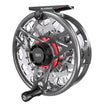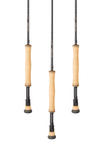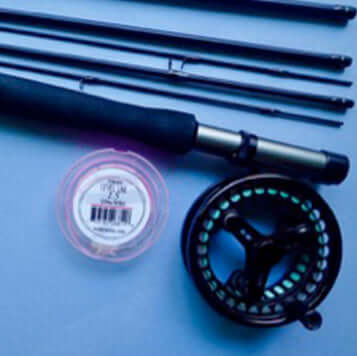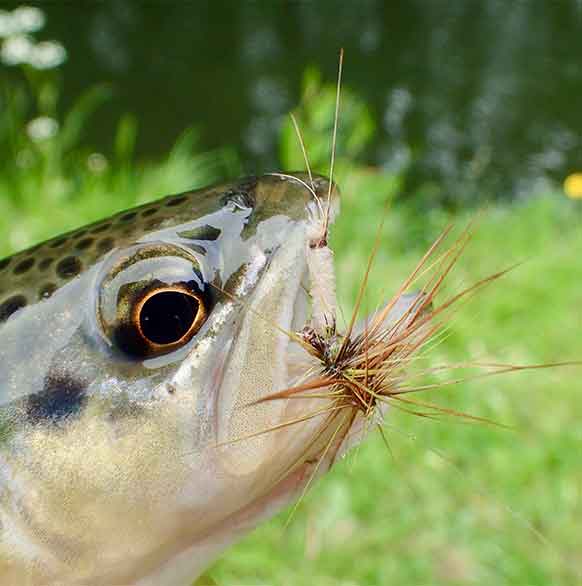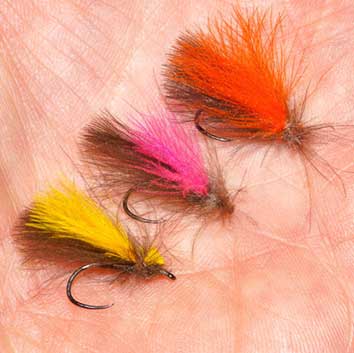Tom Bell of Sunray is an amazing designer of innovative fishing tackle. I first came across him just over two years ago when he brought out his Micro Thin fly lines designed to perform like silk lines. I particularly like his monocore Jeremy Lucas lines with their long front taper (9’) down to a staggering 0.5mm at the tip & his level Micro Nymph line with a diameter of 0.55mm. These lines cast like bullets, land like thistle down & float remarkably well considering that they are more dense than water.
He has also produced a small range of rods. Being an avid light-line flyfisher I love his 10’ 2 weight Jeremy Lucas rod, a true 2 weight which bends deeply but is crisp, with no rebound problems post cast. I fish this rod with either a Jeremy Lucas 1 weight line or a Micro Nymph line (both with 10’ to 14’ leaders/tippet). Casting with both lines is superb & protection of fine tippet is excellent (I’ve landed 3lb rainbows on size 30 dry flies & 0.09mm tippet).
Until recently I thought the Jeremy Lucas 10’ 2 weight was probably the ultimate in light line conventional rods (as opposed to Tenkara), however Tom sent me one of the prototypes for his unique 10’ 6” to 11’ 6” ZERO weight hybrid rods. Fishing with it proved to be a revelation. The design of the rod is radical, being based on Quiver Tip technology taken from coarse fishing ledger rods. It comes in 6 pieces (4 lower hollow sections & 2 solid carbon tips that slot into the top of the hollow part). The aim of this rod was to fill the gap between Tenkara with it fixed-line limitations & conventional ‘Western’ fly rod & reel.
The finish on the model I was sent is excellent, matt black blank, light weight black single leg rings with one low friction, anti-tangle stripping ring, slim black EVA handle & matt grey & black metal down sliding light weight reel seat (a cork handle version is also available). There are excellent white lines at the end of each section to help align the rings.
FOAM HANDLE VERSION
Weight: 10’ 6” = 82g (2.9oz); 11’ 6” = 83g (2.9oz)
Handle Black EVA length (including reel seat) 25.8cm (10.16”)
The most important thing for me is how the rod handles. I have tested it thoroughly at both lengths with a range of light lines from level 0.35mm (15lb) copolymer line, level fluorocarbon Tenkara lines from Japanese 2 weight to 3.5 weight, a carp shock leader tapering from 20lb to 10lb (0.5mm to 0.3mm), 2 weight Double Taper line plus 16’ leader, 1 weight Micro Thin Jeremy Lucas line & micro nymph lines of 0.55mm & 0.65mm diameter & it coped remarkably well with this wide range of line weights. At 11’ 6” I found it to be very whippy & I had to smooth my casting stroke & soften the stop to reduce post-cast tip recoil. However at 10’ 6” the rod was a totally different beast, soft, forgiving action but with a crispness & lack of tip recoil that allowed me to cast precisely & accurately with very light lines, long leaders & dry flies & small nymphs. Thanks to its flexibility line mending was excellent; just a small flick of the wrist realigned the line as required.
My first tests were on my local small still water, a U shaped canal-like water with a distinct flow & very well educated, challenging rainbows. In four short sessions targeting visible cruising fish I caught over 30 rainbows up to 3lb. Most fell for a size 18 Black Gnat, but some took a size 24 Buzzer Pupa or a size 30 CdC Midge, generally on 0.09mm tippet. The rod bent down to the handle & soaked up the surging runs & head shaking; furthermore it subdued the fish relatively quickly despite the fine tippet. This rod will handle sizeable fish! At 10’ 6” it cast superbly with a Micro Nymph line & 11’ leader/tippet, also performed well with a French Leader & a 1 weight Micro Thin Jeremy Lucas line. At 10’ 6” in calm conditions I was amazed at how far I could cast a 2.5 weight (Japanese scale which is 0.26mm/0.010” diameter/1x/10lb breaking strain) fluorocarbon level Tenkara line (over 20’ of line plus 3’ of tippet beyond the rod tip), accurately targeting cruising rainbows. At 11’ 6” casting the same lines, due to the extra long, flexible tip, it did require a very smooth casting stroke & very soft stop to avoid post-cast tip bounce.
My first trial on a river was on a desperately low & clear Yorkshire Derwent in bright sun with a tricky downstream breeze. I fished the rod at 10’ 6” with a 0.55mm diameter micro nymph line & 11’ leader/tippet with a size 20 Black Gnat or a size 20 CdC IOBO Humpy as there were clouds of Dance Flies & the few risers were taking them. The rod performed flawlessly providing accurate casting & super delicate presentation, which resulted in 14 wild brown trout being landed. Only when casting into a fresh breeze did I hit any problems with accuracy or leader/tippet turn-over. Later I used the same setup to fish a size 24 CdC Midge to some very fussy fish feeding on Aphids in the slow, smooth sections on one of West Yorkshire’s industrial rivers resulting in 17 wild brown trout up to 14” being landed. Once again presentation & accuracy were superb & I could repeatedly cover the rising fish, without spooking them, until they finally took my offering.
After several further tests I can say that, overall, for me, the best performance casting-wise was at 10’ 6” with a 0.55mm diameter Micro Nymph line teamed up with a short tapered leader plus extra tippet (7’ taper from 0.43mm to 0.2mm, plus 3’ to 5’ of tippet). Nevertheless at both lengths it cast light Tenkara lines (2.5 weight on the Japanese scale) surprisingly well & at 10’ 6” even cast a decent length of 2 weight double taper line with a 16’ leader plus size 30 dry fly.
In conclusion, in my opinion, the 10’ 6” configuration is an absolutely superb (probably the ultimate) ultra-light line rod for dry fly or Euro Nymphing. At 11’ 6” the tip is so flexible that I found it required a very smooth casting stroke with a very gentle deceleration/drift at the end of the casting stroke to reduce tip bounce or a smooth Tenkara Style casting stroke, but once I adapted to this I found that my early doubts about its effectiveness at the longer length were mostly unfounded. This rod is undoubtedly a major ‘game changer’, opening up real opportunities for the light line enthusiast. Is this rod the perfect substitute for Tenkara on waters where there are very big fish? Not quite is my opinion since even at 11’ 6” it is a little short for some of the waters that I fish with my 13’ 6” & 14’ 6” Tenkara rods when I want to hold all of the line & most of the tippet off the water. A 13’ version with the same action as the 10’ 6” configuration would be the answer to all of my prayers!

This rod will cast everything from a light, 2.5 weight (Japanese Scale) Tenkara line to a 2 weight Double Taper.

This rod can cope with good sized fish.

When playing big fish this rod absorbs a lot of energy & gives great protection to light tippets.

It is also great fun with smaller wild trout.






